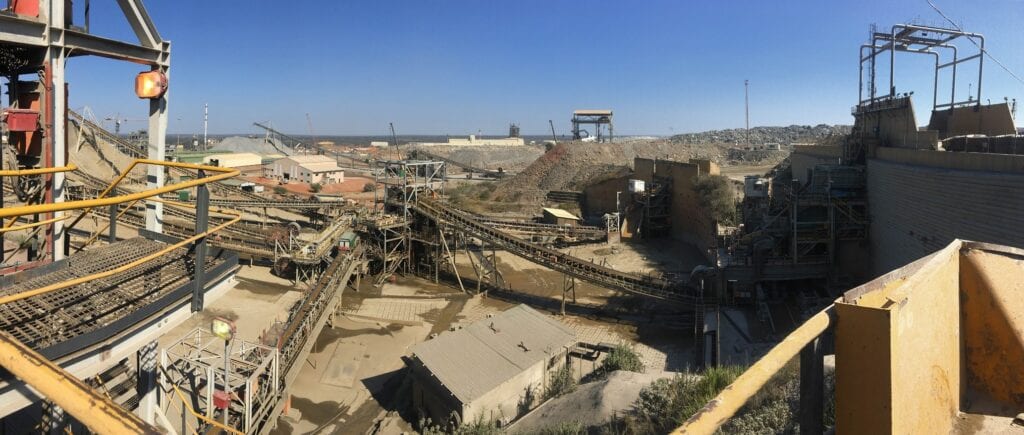South America, the world’s leading copper producing region, was significantly affected by COVID-19 restrictions in 2020, particularly in the second half of the year.
However, with production continuing to ramp up in Chile and Peru, the world’s top two copper producing countries, and with new projects on the path to development, South America looks set to retain its global dominance.
And while the region was very hard hit by COVID-19 over the past 12 months, Chile, clearly the world’s leading copper mining destination, still managed to produce an estimated 5.7 million metric tons of copper in 2020.
The International Copper Study Group’s (ICSG) recently released February 2021 Copper Bulletin said Chile’s output was up by 2.5% in the first half of 2020, recovering from production constraints in early 2019 (output had declined by 2.5% in the first half of 2019). However, with a 2.9% decline over July-November 2020 compared to the same period of 2019, accumulated output in the first 11 months of 2020 remained essentially unchanged.

The ICSG noted that in Peru, stoppages resulting from the COVID-19 pandemic combined with operational issues and adverse weather that affected a few major mines, led to a 13.5% decline in mine output over the first 11 months of 2020 including a significant decline of 38% in April-May compared with the same period in 2019.
However, it reported that as the Peruvian mining industry started to recover, the extent of the reduction narrowed, with October and November output being the highest of the year.
Pricing
The recent upward production momentum in South America was aided by strong copper price growth during the second half of 2020.
That positive increase in pricing is tipped to continue throughout 2021.
Canaccord Genuity mining analyst Dalton Baretto recently forecast that copper values for the first quarter of 2021 rose from US$3.50 per pound to US$3.75 per lb, with an estimated jump to $3.90 per pound forecast for the second quarter.
According to Baretto, Copper prices are up seven percent so far in 2021, and the physical market is tighter than it has been since the peak of the last commodity cycle prior to the GFC. He also suggested copper could even hit US$4.00 per lb in the near future.
In his note, Baretto said the drivers for price growth are significant liquidity coupled with positive sentiment around a global reflation, infrastructure-focused stimulus, vaccine-driven demand boost and a US$ poised to weaken.
Another sign of the pricing strength, was confirmed when copper futures for March delivery advanced 0.3% to $3.652 per pound on the Comex, surpassing a near eight-year high set in December.
Renewable energy
Along with a shortage of production due to COVID-19 restrictions, and the maturation of mines around the globe, copper is benefitting from its growing appeal to the renewable energy market.
Copper is used in high, medium, and low voltage power networks, and copper conductivity is considered to be the standard by which other conductors are measured.
Due to its capacity as a highly efficient conduit, copper is used in renewable energy systems to generate power from solar, hydro, thermal, and wind energy across the world.
Copper helps reduce CO2 emissions and lowers the amount of energy needed to produce electricity. In many renewable energy systems, there is 12-times more copper being used than in traditional systems to ensure efficiency.
Copper is also considered essential to electric vehicle (EV) technology, according to the Copper Development Association Inc. (CDA).
The CDA said copper is used in the electric motors, batteries, inverters, wiring and in charging stations because of its durability, malleability, reliability, and superior electrical conductivity.
An EV can use between 85 and 183 pounds of copper and hybrid, and electric buses can contain between 183 and 814 pounds.

Copper is also an indispensable component of the infrastructure needed to support electric vehicle charging. To power the EVs of both today and tomorrow, a network of five million charging ports will be needed within the next decade.
A who’s who
The increase in price and forecasts for continued growth has attracted new investment in copper exploration and development in South America.
Candente Copper’s (TSX: DNT) large Cañariaco Norte deposit in Peru has been rated by Goldman Sachs as one of the world’s top 84 copper projects.
A feasibility study has identified Cañariaco as a porphyry copper deposit containing 7.5 billion pounds Measured and Indicated which can be mined for 22 years once in production.
In its steady path to production, Candente Copper recently engaged Ausenco Engineering Canada Inc. to conduct Desk Top Studies to identify and define a smaller, higher grade, start-up option for Cañariaco with a smaller initial capital expenditure (CapEx) and accelerated payback period.
Assuming favourable results from the Desk Top Studies, the company said it would look to move into PEA on the Revised Project Concept.
Meridian Mining UK (TSXV: MNO) has been granted a key environmental permit required for commencing exploration activities at its Cabaçal VMS Copper-Gold project in Brazil.
The permit allows the company to roll out its first diamond drilling and geophysical campaigns. Two diamond drill rigs will conduct the 10,000m drill programme, with an initial focus on the historical high-grade copper-gold southern zone.
Meanwhile, Solaris Resources Inc. (TSX: SLS) recently reported promising assay results from a series of additional holes from the ongoing diamond drilling programme at its Warintza copper and Mollybendum project in south-eastern Ecuador.
Recent extensional drilling continues to grow the project which currently has an In-Pit Inferred Resource of 124 Mt @ 0.70% CuEq (0.56% Cu, 0.03% Mo, 0.1 g/t Au) based on minimal historical drilling to 200m on discovery outcrop (2000-2010).
Cornerstone Capital Resources Inc (TSXV: CGP) has identified several high priority porphyry Cu-Mo (Au) drill targets within two main areas at the Espejo project located within the company’s Ecuador S.A. (CESA) – ENAMI EP strategic exploration alliance.
3D magnetic inversion modelling indicates strong and extensive magnetic anomalies below the 1.9km by 1.3km ESP #1 Cu-Mo (Au) anomaly and the 1.0km to 0.7km ESP #2 anomaly where anomalous Cu-Mo (Au) in rocks was confirmed by systematic soil sampling.
A Phase 1 drilling programme of 30 holes for 17,000m has now been defined.
Elsewhere in Ecuador, ASX-listed Titan Minerals Limited (ASX: TTM) has identified a range of exciting new targets from the results of surface geochemistry sampling and initial results for the aerial geophysical survey at the Copper Duke Project.
The results continue to highlight significant extensions of known copper anomalism across the Copper Duke Project as the footprint of geochemical coverage expands, and they identify several new high-grade gold quartz veins that potentially represent additional exploration targets for evaluation.












